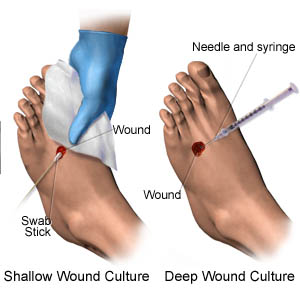Wound Culture Test Overview
A wound culture is a test to find germs (such as bacteria or a fungus) that can cause an infection. A sample of skin, tissue, or fluid is added to a substance that promotes the growth of germs. If no germs grow, the culture is negative. If germs that can cause an infection grow, the culture is positive. The type of germ may be identified with a microscope or chemical tests. Sometimes other tests are done to find the right medicine for treating the infection. This is called sensitivity testing.
Most bacteria can grow in oxygen. They are called aerobic bacteria and usually are found in wounds close to the skin surface (superficial). Bacteria that cannot grow in the presence of oxygen (anaerobic) usually are found in deeper wounds and abscesses. A wound culture can find out whether bacteria are aerobic or anaerobic.
A fungal culture is done to find out if an infection is caused by a fungus. A viral culture can be done to find out whether an infection is caused by a virus.
Goal:
Identify organisms colonized within a wound so that antibiotics sensitive to the microorganisms can be prescribed, as needed.
CLICK HERE for Free NCLEX –RN & CGFNS Practice Questions
Procedure:
1. Identify the patient using two separate identifiers.
2. Close door or bed curtains and explain the procedure to the patient, if possible.
3. Verify order for culture noting site and type of culture. Label the specimen container and make sure the information includes the patient’s name, medical record number, date and time specimen is obtained, and site of the culture.
4. Perform hand hygiene and don gloves.
5. Remove soiled dressing. Observe drainage for amount, odor, and color.
6. Clear and remove exudate from around wound and cleanse with normal saline.
CLICK HERE for more resources on Laboratory & Diagnostic Test
Obtaining Aerobic Culture
1. Perform steps 1 through 6 above.
2. Using sterile swab from culture tube, insert swab deep into area of active drainage. Rotate swab to absorb as much drainage as possible.
3. Insert swab into culture tube, taking care not to touch the top or outside of the tube.
4. Crush ampule of medium and close container securely.
5. Continue with step 4 below.
Obtaining Anaerobic Culture
1. Perform steps 1 through 6 at beginning of procedure.
2. Using sterile swab from special anaerobic culture tube, insert swab deeply into draining body cavity.
3. a. Rotate swab gently and remove. Quickly place swab into inner tube of collection container.
b. Alternative method: Insert tip of syringe with needle removed into wound and aspirate 1 to 5 mL of exudate. Attach 21-gauge needle to syringe, expel all air, and inject exudate into inner tube of the culture container.
4. Send specimens in the pre-labeled containers with appropriate requisition immediately to the laboratory. Some agencies require that specimens be transported in clean plastic bags to further prevent transfer of microorganisms.
5. Clean and apply sterile dressings to the wound, as ordered.
6. Remove and discard gloves. Perform hand hygiene.
7. Document all relevant information on the patient’s chart. Include the location the specimen was taken from and the date and time. Record the wound’s appearance and the color, odor, amount, and consistency of drainage. Record
how the patient tolerated the procedure and any discomfort that he or she experienced.

